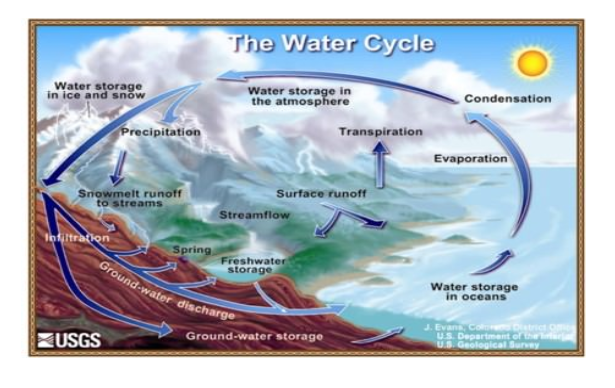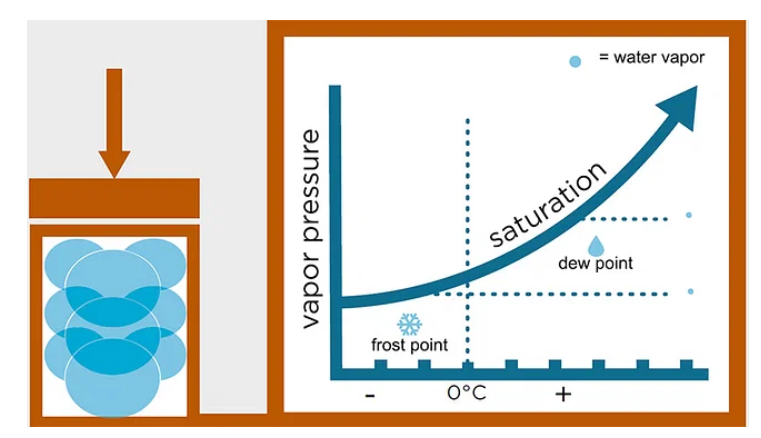- Humidity denotes the quantity of water vapour present in the atmosphere.
- The air's capacity to retain water vapour is dictated by its temperature.
- There are three main classifications of humidity: absolute, relative, and specific humidity. These different forms of humidity measurements offer distinct insights into the moisture content in the air.
WATER CYCLE - HYDROLOGICAL CYCLE
- The movement of water across the Earth involves an ongoing exchange between the atmosphere, oceans, and continents through several processes: evaporation, transpiration, condensation, and precipitation.
- Water vapour in the atmosphere originates from water bodies through evaporation and from plants through transpiration, collectively known as evapotranspiration.
- Evaporated water transforms into clouds through condensation. When these clouds reach saturation, they release water in the form of precipitation, such as rain or snow.
- Maintaining equilibrium within the system requires a balance between the amount of water lost through evapotranspiration and the quantity returned through precipitation.
- This equilibrium is sustained by the hydrological cycle, ensuring a continuous and balanced movement of water throughout the Earth's systems.

WATER VAPOUR IN ATMOSPHERE
- The quantity of water vapour present in the air ranges from zero to four percent by volume of the atmosphere, with an average around 2% in the atmosphere.
- The measurement of the amount of water vapour, which is referred to as humidity, is typically assessed using an instrument called a hygrometer.
TYPES OF HUMIDITY
ABSOLUTE HUMIDITY
- Absolute humidity defines the mass of water vapour present within a given volume of air.
- It is typically measured in grams per cubic metre.
- However, its usage in meteorology is relatively limited due to its variability across different locations on the Earth's surface.
- As an air mass rises or falls, its volume changes, causing the absolute humidity to fluctuate due to the expansion or contraction of the air.
- This variability makes it less commonly employed by meteorologists for detailed analysis or calculations.
- Consequently, meteorologists often use other measurements of humidity that allow for easier comparisons and calculations in weather analysis.
RELATIVE HUMIDITY
- Relative humidity is the ratio between the total capacity of air to hold moisture at a specific temperature and the actual quantity of moisture it currently contains.
- It's typically measured in percentages. As temperature increases, relative humidity tends to decrease.
- Over the oceans, relative humidity tends to be higher, while over continental areas, it is generally lower due to various atmospheric conditions and proximity to water bodies.
The dew point temperature is the specific temperature at which the relative humidity reaches 100%, signifying that the air is fully saturated with moisture. In simple terms, it's the temperature at which condensation starts when air is cooled. This temperature corresponds to the saturation temperature of water vapour at its particular partial pressure in the air.
SPECIFIC HUMIDITY
- Specific humidity quantifies the weight of water vapour contained within a specific weight of air.
- It's typically measured in units such as grams per kilogram.
- Unlike absolute and relative humidity, specific humidity remains unaffected by alterations in pressure or temperature because it is gauged in weight units.
- Specific humidity is considered a constant value as it directly measures the actual weight of water vapour in a given mass of air, while absolute and relative humidity are more susceptible to variations due to changes in atmospheric conditions like temperature and pressure.
DEW POINT
- The dew point marks the temperature at which the air holds moisture to its maximum capacity, indicating complete saturation at 100% relative humidity.
- At this stage, the air is incapable of containing any additional moisture.
- Vapour condenses when the air's temperature drops below the dew point temperature. If the dew point is above 0 degrees Celsius, the vapour condenses into liquid droplets. Conversely, when the dew point falls below 0 degrees Celsius, the vapour forms into ice crystals.
- Condensation in the open atmosphere takes place when minute particles called hygroscopic condensation nuclei cool.
- These particles, such as dust, smoke, and sea salt, possess the capability to absorb water, making them particularly effective nuclei for condensation.

- The dew point temperature refers to the specific temperature at which humid air or gas needs to be consistently cooled at a constant pressure for condensation to initiate.
- It represents the threshold temperature at which the air reaches its saturation point and begins the process of condensation.
SIGNIFICANCE OF HUMIDITY
- Humidity significantly influences human health by affecting thermal comfort.
- The presence of humidity in the air has a notable impact on our well-being.
- It can store a substantial amount of energy, and when it converts to a liquid state, such as during rain, it releases that stored energy.
- Humidity plays a crucial role in stabilising our climate.
- Its presence in the atmosphere helps mitigate severe temperature fluctuations.
- It moderates extreme temperature swings, contributing to a more stable and balanced climate due to its capacity to absorb and release energy.
FAQs on Humidity, Water Cycle, and Significance:
1. What is humidity, and what are its main types?
Ans. Humidity represents the amount of water vapour in the air and is classified into three main types: absolute, relative, and specific humidity. These different forms of humidity measurements offer distinct insights into the moisture content in the air.
2. How does the water cycle work?
Ans. The water cycle involves continuous movement of water through various processes, including evaporation, transpiration, condensation, and precipitation. Water vapour in the atmosphere originates from sources such as water bodies and plants through evapotranspiration.
3. What are the different types of humidity, and how are they measured?
Ans. Absolute humidity measures the mass of water vapour in a given volume of air and is often expressed in grams per cubic metre. Relative humidity quantifies the ratio between the air's moisture capacity and its actual moisture content, typically in percentages. Specific humidity measures the weight of water vapour in a specific weight of air, commonly in grams per kilogram.
4. What is the dew point, and how does it impact condensation?
Ans. The dew point is the temperature at which air becomes saturated, holding moisture to its maximum capacity at 100% relative humidity. When the air's temperature drops below the dew point, condensation occurs, forming liquid droplets if the dew point is above 0 degrees Celsius or ice crystals if below.
5. How does humidity impact human health and climate?
Ans. Humidity significantly influences human health by affecting thermal comfort. It also plays a crucial role in stabilising the climate, moderating extreme temperature swings by absorbing and releasing energy.

